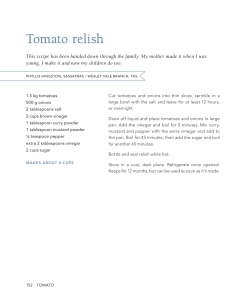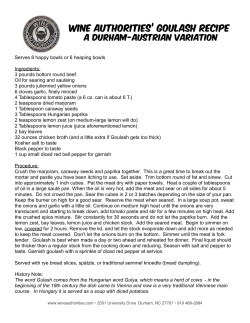
ROOTING FOR ONIONS
ROOTING FOR ONIONS By Gwen O’Reilly Onions in everything – that is my motto in the kitchen. I have been struggling to grow various forms of the damn things for many years. O nions are one of the oldest cultivated crops, temperatures consistently higher than 30OC will and there are many representatives of the reduce the size of the bulb. Allium family in my garden: leeks, chives, Aside from being picky about day length and garlic, shallots, Welsh onions and Egyptian onions. temperature, onions are fussy in terms of moisture But in this article, I’ll concentrate on Allium cepa— levels and soil conditions. They are shallow rooted, the common onion. and require constant moisture to allow the inner scales Common onions are perennial plants usually to plump up. If the supply of moisture is interrupted, grown as annuals. When exposed to the correct day outer scales will begin to form as the plant prepares length and temperature, they will form a bulb. to mature. The arrival of water after a sustained Getting them to bulb is dry period can cause not often a problem. The growth to resume, which tricky part is providing results in the onion for adequate moisture “splitting” by forming a and fertility at the right new bulb beside the time so that they achieve original. a reasonable size and do Onions love rich, not split or bolt. mellow soils that are Common onions are high in organic matter categorized into three and relatively neutral or types—long-day, shortonly slightly acidic. The day and intermediate. best crop I’ve ever had Long-day onion varieties was grown in a garden are sensitive to the longer previously under an old days (or more accurately, horse barn. Hot manure shorter nights) of the is not advisable—some growing season in sources suggest it northern latitudes and increases the possibility In the Maritimes, TCOG editor, Janet Wallace, will initiate bulb of onion maggot grows delicious, softball-sized Ailsa Craig and Walla formation when days are infestation. Walla onions. more than 14 hours long. I grow onions in beds Short-day cultivars start that have been heavily to bulb at 12 to 13 hours of daylight and are grown manured the previous year, following crops such as in southern areas. Milder or sweet onions like Vidalia corn or squash. Onions cannot tolerate much tend to be short-day onions. Pearl (pickling) onions competition, and their shallow roots make for are actually short-day onions grown in northern difficult weeding, so use beds that are as weed-free latitudes. as possible. Regular rotation is important to avoid Both short- and long-day types have specific the establishment of pests. (Beware those lovely temperature requirements. Bulbs will not form if volunteer onions from last year, as they may be average daily temperatures are below 15 O C; harbouring some unwelcome occupants.) 16 – Fall 2008 The Canadian Organic Grower www.cog.ca Go forth and multiply My onion growing career started with grocery store sets—miniature onion bulbs that allow a head start on the season. I relied on good old Yellow Dutch, sometimes Spanish and old-fashioned multiplier (a.k.a. potato) onions. Multipliers are easy, hardy and prolific. They acquired the potato moniker because they grow further under the surface than other varieties. With good conditions, the clumps of small bulbs grow to a useable size and store very well. They can also be harvested early for green onions. Get ready, or get sets Planting sets is an easy way to get a decent crop, but the selection of varieties is limited, and they take some time to become established. I was lured into growing transplants from seed by the greater selection of both hybrid and open-pollinated varieties now available. Aside from a selection of varieties bred for sweetness and storage (which, by the way, are usually mutually exclusive characteristics), transplanting onion seedlings allows you to make full use of a short season, because they are already actively growing. Organic growers may prefer transplants because certified organic onion sets are not available commercially. Some certification bodies may allow conventional sets if the grower can prove organic sources are unavailable. I seed onions for transplant indoors in late February. I have adapted the Eliot Coleman style of seeding and use soil blocks or sometimes just large plastic cells and soil mix (if I’m short on time). Because hybrid seed is expensive, I don’t broadcast, but painstakingly plant three or four seeds per block. Some years I thin them to two seedlings per block, sometimes not. They seem to thrive with multiple plants per cell. Seedlings get the occasional haircut, but I make sure not to trim the inner youngest leaf. If they are lanky, I trim www.cog.ca them to about 15-cm (6-in.) long before transplanting in the spring. The books say the seedlings should be about pencilthick before planting, but I transplant them at half that size and still get good results. I’ve tried the Coleman idea of planting out multiple seedlings together, but had no success with it— the bulbs didn’t size up. So, I separate seedlings and plant them individually, about 10–15 cm (4–6 in.) apart. My favourite hybrid varieties are Copra, Sweet Sandwich, Candy, Norstar and First Edition. My favourite open-pollinated onion is the Italian Cippolini (Boretana), a small, flattened and fast-growing white or purple variety. Sets happen I discovered how to grow onion sets by accident. I left an extra tray of seedlings beside my greenhouse one year. As the season progressed, they formed miniature bulbs, just like the sets in the grocery store bins. Commercial sets are grown in similar closely-spaced conditions in light, less fertile soil. The trick is to get them to just the right stage of development before hardening off. If they are too far along, they flower when The Canadian Organic Grower Fall 2008 – 17 planted the next year. If not developed enough, they will not store well. I’ve also tried late summer seeding with limited success—it is hard to overwinter small bulbs in the ground in cold climates. Someday, I hope to figure out a winter mulching system that will allow this in Zone 2b, where I garden. Whether you grow from sets or seed, I recommend mulching. Be careful doing it; onions are very susceptible to physical injury. I try to either mulch before transplanting, or use straw that is older or chopped, so as not to injure the seedlings. Grass trimmings make a perfect mulch, just make sure they are reasonably free of weed seeds. I also put up a temporary fence around the beds to keep out animal traffic. Gwen O’Reilly grows organic Alliums, among other things in the Kaministiquia Valley in Northwestern Ontario, and is a contributing editor for The Canadian Organic Grower. Photos provided by Janet Wallace. Whether you grow from sets or seed, I recommend mulching. Some gardeners bend over the tops of onions to hasten maturity for harvest. Others suggest that this is not the best method; stem injury may introduce bacteria that cause rot. One grower recommends gradually drawing soil away from the tops of the onion to hasten maturity. You may deduce from the accidental set production that I am a laissez faire gardener so, of course, I just wait until most of the leaves are yellow and have fallen (or been knocked) over on their own. That seems to work just fine. After harvest, the plump onions should be cured in a warm, dry space for several days until stems are dry. Then, they should be stored in a cool (just above freezing is good), dark, dry place. Good storage conditions are important to keep organic onions over the winter. I’ve been known to pot up mid-winter sprouters for an early indoor crop of green onions. Follow these tips and, with any luck, the only tears onions will bring to your eyes will be over the cutting board. Resources Onions, Leeks and Garlic: A Handbook for Gardeners. Marian Coonse, Texas A&M University Press, 1995. Garlic and Friends: The History, Growth and Use of Edible Alliums. Penny Woodward, Hyland House, 1996. Organic Allium Production. 2008. attra.ncat.org/attra-pub/ allium.html Onion Crop Overview. Saskatchewan Agriculture and Food. 2008. www.agriculture.gov.sk.ca 18 – Fall 2008 The Canadian Organic Grower www.cog.ca
© Copyright 2025













